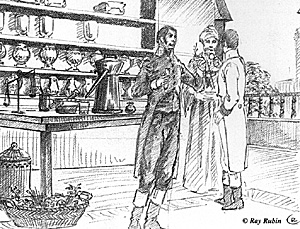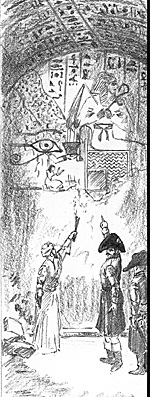
As audacious as Napoleon's expedition to Egypt was from a military standpoint, his scientific and cultural mission to study every facet of Egyptian history, culture, and geography was equally ambitious. To accomplish this quest, the 28-year-old General Bonaparte assembled a most impressive group of scholars, including many of France's leading luminaries, to accompany his army on its remarkable adventure.
The ruling Directory of France hoped to strike a blow at its major enemy, Great Britain, by capturing Egypt and making it a base to threaten England's holdings in India. It therefore authorized the military invasion force to be commanded by Bonaparte, France's most successful field commander, fresh from his successes in Italy in 1796-1797.
 A decree from the Directory dated 26 March 1798 instructed the Minister of the Interior to give Bonaparte the necessary equipment and manpower for his project. With remarkable speed, the
young general assembled his expeditionary force and set sail less than two months later.
A decree from the Directory dated 26 March 1798 instructed the Minister of the Interior to give Bonaparte the necessary equipment and manpower for his project. With remarkable speed, the
young general assembled his expeditionary force and set sail less than two months later.
Although Napoleon was enthusiastic about the idea of scientific and cultural exploration, he could not personally oversee recruitment of specialists because he had to organize the military details of the invasion force. He delegated much of the task of gathering civilian engineers, linguists, artists and scholars (known collectively as "savants") to men whom he trusted. General Louis Caffarelli, commander of the Corps of Engineers and an avid astronomer, supervised the administrative and financial details. The famous chemist Claude-Louis Berthollet, a personal friend of Bonaparte, recruited many of the scientists and technicians by contacting France's elite institutions like the Polytechnic School and Museum of Natural History. The destination was kept secret, so those approached were told only that they were needed for a mission commanded by Bonaparte on behalf of the Republic. They were assured that their stipends and positions would be protected in their absence.
Not all individuals were eager to join the project. The famed naturalist Georges Cuvier declined the honor. The well-known and patriotic mathematician, Gaspard Monge was approached by the Directory, but refused at first, probably because of his wife's concern that he was too old (around fifty!). Bonaparte presumably interceded, and soon Monge was enthusiastically gathering Arabic printing equipment for the expedition (which must have given him a clue as to the final destination).
... the 28-year-old General Bonaparte
assembled a most impressive group of scholars....
Berthollet approached Geoffry Saint-Hilaire, a talented zoologist from the Museum of Natural History, as well as Deodat Dolomieu, a promising mineralogist (who would never return home from the expedition, dying in a Bourbon prison in Naples). The art historian Denon found out about the plans through his social acquaintance with Bonaparte's wife Josephine and subsequently volunteered. Rene Edouard Devilliers, one of forty young engineering students solicited for the expedition, was nominated by mathematician Joseph Fourier, who had himself been asked to join the group.
Nearly 200 civilian researchers formed what became known as the Scientific and Artistic Commission. They were a very diverse group; some were established and even famous, while many were young students. The administrative apparatus created by the government to organize the men divided them into different pay ranks, which caused divisiveness. Few men were accorded the highest rank, and most felt worthy of it. Moreover, many of the generals and admirals resented the ranking of civilians, and some were annoyed that Bonaparte devoted so much time to discussions with his favorite scientists on board ship during the voyage to Egypt.
The same sort of bickering occurred throughout the duration of the Institute of Egypt, officially installed on 23 August 1798. Fourier and SaintHilaire seemed to compete for prestige, and most of the civilians resented what they felt was the interference of General Menou. Many of the soldiers regarded the Institute with disdain, referring to it as Bonaparte's favorite mistress, and jokingly called the many donkeys found in the Cairo streets half savants.
More Napoleon Explores Egypt
-
Napoleon Explores Egypt: Introduction
Napoleon Explores Egypt: Organization of Scholars
Napoleon Explores Egypt: Achievements of Scholars
Napoleon Explores Egypt: Diorama of Ruins
Napoleon Explores Egypt: Campaign Medals
Related
Back to Table of Contents -- Napoleon #14
Back to Napoleon List of Issues
Back to MagWeb Master Magazine List
© Copyright 1999 by Napoleon LLC.
This article appears in MagWeb (Magazine Web) on the Internet World Wide Web.
The full text and graphics from other military history magazines and gaming magazines are available at http://www.magweb.com
Order Napoleon magazine direct